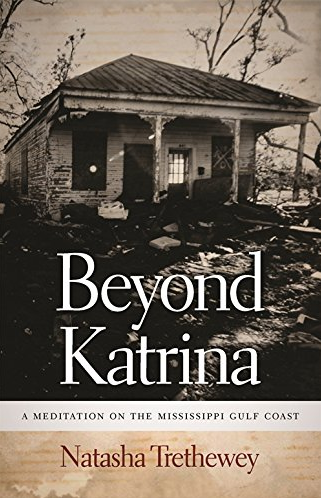Book by NATASHA TRETHEWAY
Reviewed by
 I was reading my five-year-old son a story about dragons, when he threw me an unexpected question: “Dad? Was Katrina some kind of monster? Robbie’s big brother was talking about her at school. He said Katrina smashed his grandparents’ house a long time ago.”
I was reading my five-year-old son a story about dragons, when he threw me an unexpected question: “Dad? Was Katrina some kind of monster? Robbie’s big brother was talking about her at school. He said Katrina smashed his grandparents’ house a long time ago.”
For most of us living close to the Gulf of Mexico, Hurricane Katrina, which struck on August 29, 2005, was a monster of nearly mythical proportions, and for my son who was born five years later, the carnage Katrina inflicted seems beyond reality, the work of cartoon meanies with raspy voices and serrated teeth. Yet she was entirely real, and the destruction she wrought created millions of individual stories that make up the larger story of our nation’s weird relationship with Katrina.
In her reissued and updated memoir, Beyond Katrina, poet Natasha Trethewey, a native of Gulfport, Mississippi, tells lots of stories about the coast, beginning in 2007, two years after the hurricane. Unlike much of the Katrina literature, which centers around New Orleans, this book is set farther east, near the midpoint of the Mississippi coast, where things supposedly turned out better. As the title suggests, Tretheway uses Katrina as the jumping-off point for a broader essay on the way it has changed the region.
In the initial section, she shows us the psychic scars of the disaster. We learn that coastal residents refer to things as BK or AK: Before Katrina or After Katrina. The worst hurricane BK was 1969’s Camille, a storm that washed some boats ashore and destroyed buildings, but with far less rage than Katrina. We are told of Trethewey’s aging grandmother, struggling with dementia, whose memory has conflated the two storms. Always the poet, Trethewey uses this as metaphor:
She has layered on the old story of Camille the new story of Katrina. Between the two, there is the suggestion of both a narrative and a metanarrative—the way she both remembers and forgets, the erasures, and how intricately intertwined memory and forgetting always are.
When Mississippians talk about the storm, we invariably contrast our successful resurrection to Louisiana’s extended zombie state. The easy narrative is this: things (like levees and local government) worked here; in Louisiana, they failed miserably. Here, volunteer efforts led the way; there, a corrupt and ineffective set of decision-makers allowed poor people to die. But Trethewey refuses to let that oversimplification go unchallenged. She uses it as a template for the way that simple stories about Katrina are often untrue or only half true. She points out that the first businesses to re-open on the Mississippi coast were the “boats,” as they are known—floating casinos, created by the 1992 legislation legalizing gambling in Mississippi, which restricts casinos to navigable water. With their deep pockets, the casinos could fund their own rebuilding; and with their huge contributions to the state’s tax coffers, their ability to get rebuilding permits was unsurprisingly easy, according to Trethewey.
They brought jobs to one of the most economically depressed areas of the country. Embraced because people “feared an erosion of the coast’s cultural heritage [and] the depletion of wetlands,” they turned quaint towns into neon-lit gambling resorts with their own brand of desperation, such as car-title loan businesses, places that give high-interest loans using car titles as collateral, with “the same cars parked [outside] month after month.” The story of the casino boats isn’t simple: neither is our Katrina story.
About half of Beyond Katrina explores life on the coast BK. Trethewey’s family history is entwined with the broader history of the Mississippi coast. Trethewey’s great uncle, “Son” Dixon, born at the turn of the 20th century when his former Delta sharecropper parents moved to the coast, slowly established himself as a businessman in Gulfport’s black community. Son owned several rental houses and was known as a good landlord among people for whom housing was sometimes a struggle. After World War II, shipbuilding became a major part of the coast’s economy, and Son, using veteran’s benefits, built nightclubs catering to shipbuilders. Parallel to Son’s story, Trethewey traces Gulfport’s rise as a shipbuilding center for the country and the transformation of the Mississippi coastline from marshy wetland to the nation’s longest manmade beach, 26 uninterrupted miles.
In these history lessons, Tretheway zooms in on her family, Son Dixon in particular, while simultaneously giving the larger, wide-angle view. The story-within-a-story frames how she talks about its present, too. The small stories of Katrina’s destruction and aftermath reveal that larger economic interests have used the disaster to push out small businesses. A friend of her late great-uncle, Cicero Tims, owns a snow cone stand in the north Gulfport neighborhood Trethewey’s family has called home for years. Permits to make renovations and repairs on existing structures were difficult enough to come by, but city officials outright refused to give permits for complete rebuilds—and often, rationale was never given. In Tims’s words:
I’ve had to start over several times in my life when everything I had was destroyed. This time, the city won’t let me rebuild my business the way I want to. This old shack that my snowball stand is in—I can’t even tear it down to build a new one. If I tear it down, the city takes the land. I’m only here now because of the grandfather clause. If your business was here before a certain date, you can keep your property. But if you tear it down to do something else, it’s gone.
This hardly sounds like the plucky, well-run, relatively egalitarian story that Mississippi rubs in the face of Louisiana. From Tims’s struggle, Trethewey pulls back the camera to expose disparities in how Federal-rebuilding money was distributed, how restrictions were enforced in some places but ignored in others. “Instead of replacing all of the low-income housing lost in the storm,” Trethewey says, “the state of Mississippi found ways to divert those funds for such things as the refurbishment and expansion of the Port of Gulfport [the Gulf’s major importing gateway]—a project that was in the planning stages long before Katrina hit.”
Trethewey’s brother, Joe, inherited most of the properties owned by Son Dixon. Before the storm, Joe was continuing in his great-uncle’s footsteps as a landlord, and using his skills as a builder to expand into his own small contracting business. Despite his skill and reputation, Joe was unable to find steady work to keep up the tax and mortgage payments on his uninsured properties. He made the “desperate decision” to transport and deliver several ounces of cocaine for an acquaintance. It yielded a quick $4,000, a few more deliveries, and tragically, a felony conviction. Joe’s heartbreaking story takes up a significant, essential amount of the book. Trethewey recounts her correspondence with Joe, giving us his own meditations on life, justice, and punishment. Joe attended their mother’s funeral in an orange jumpsuit and leg shackles, flanked by armed policemen, even while privately viewing his mother’s casket. Barred from any physical or verbal contact, the siblings share only a silent, sustained period of eye contact before Joe is ushered back into the armored van and taken back to prison.
Tretheway makes a convincing case that none of this would have transpired had Katrina not wiped out the coast, had rebuilding funds been fairly handled, had city governments not placed undue burdens on small, mostly minority-owned businesses.
Before Beyond Katrina, Trethewey made her mark on American letters as a poet. Her debut collection, Domestic Work, was awarded the Cave Canem prize. Native Guard, her third collection, won the Pulitzer in 2007, and she was named U.S. Poet Laureate in 2012. Her quick, dense prose reflects her roots as a poet: “the landscape is inscribed with the traces of things long gone… Names are talismans of memory too—Katrina, Camille. Perhaps this is why we name our storms… I know that [writing] is a form of rebuilding.” A lovely surprise for me was the inclusion of her own poetry. “Theories of Time and Space,” a poem from Domestic Work serves as an epigraph for the book:
You can get there from here, though
there’s no going home.Everywhere you go will be somewhere
you’ve never been. Try this:head south on Mississippi 49, one-
by-one mile markers ticking offanother minute of your life. Follow this
to its natural conclusion—dead endat the coast, the pier at Gulfport where
riggings of shrimp boats are loose stitchesin a sky threatening rain. Cross over
the man-made beach, 26 miles of sanddumped on the mangrove swamp—buried
terrain of the past. Bring onlywhat you must carry—tome of memory,
its random blank pages. On the dockwhere you board the boat for Ship Island,
someone will take your picture:the photograph—who you were—
will be waiting when you return.
In the book’s midsection, a lovely sheaf of poems springs up, meditating on (and even borrowing language from) some of the people and stories in the book’s prose chapters. Trethewey’s voice as a prose writer is good, but her poetry truly shines, and having some tight stanzas in the midst of larger paragraphs is a welcome break.
Beyond Katrina was originally published in 2010—five years after landfall—and was reissued this year to commemorate the 10-year anniversary of the storm. This new edition contains an epilogue, rounding out Joe’s story—he’s been released, and is living in Atlanta with his wife and daughter. However, Trethewey doesn’t provide us will full closure, either. She mentions a politician’s billboard boasting the words: “Katrina isn’t over.” The coast’s future is “ever evolving,” she writes. The monster is dead, but not entirely gone.
James Dickson’s teaches English and Creative Writing at Germanton High School in Madison, MS. His poetry appears in The Louisiana Review, Spillway, Glassworks, and other journals.



